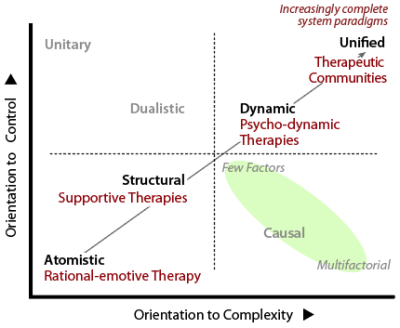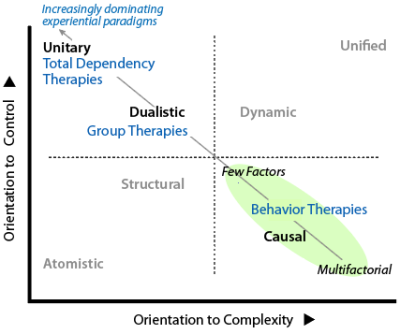Personal Change
Change Foci
The three obvious foci for change are personal, organisational and societal.
- Societal change is commonly about work on societal institutions.
- Organisational change is commonly about strengthening the management culture.
- Personal change is commonly about self-development.
However, this investigation of within the has offered a different perspective.
- Societal change requires a political ideology.
- Organisational change requires leadership.
- Personal change is examined in this topic.
Any therapeutic approach requires a perspective on what is meant by «a person» i.e. how to depict a person. We now know there are distinct alternatives for depiction, and each can be expected to generate a distinctive form of therapy. However, as explained below, personal change does not necessarily involve a therapist.
Becoming Engaged
When «personal growth» is the concern, the image is one of evolution by looking inward, which indicates use of that lie on the system diagonal. Here, a person is expected to become engaged as an active participant in the change process (as explained earlier).
Rational-emotive therapy is a cognitive approach to change in which a person is encouraged to focus on their irrational beliefs and the way they generate inappropriate emotions and disruptive thoughts and behaviours. The person seeking change is helped to take responsibility for their own thinking and modify or reject beliefs so as to produce more constructive personal and social outcomes. Techniques can also include meditation, journalling and guided imagery.

This account is consistent with depiction via the .
Supportive therapy takes the person as they are and aims to help them understand and deal with their current situation. Regular discussions are arranged and counselling and advice are directed at problems. This is probably the most ubiquitously used form of psychotherapy. The therapist is expected to be positive and accepting, while reflecting back to the person their patterns of functioning without criticizing or confronting defences. The focus is on assisting with effective adaptation to environmental realities.
This account is consistent with depiction via the .
Psycho-dynamic therapies come in a many varieties, but they all have in common the notion that a person is a «self» and that self is a complex entity made of drives, wishes, fears, memories, self and object images and more. The interactions amongst these is what causes the symptom or character problem. Engaging so as to help the person recognize and dissolve inner inhibitions and conflicts is the essence of therapy.
This account is consistent with depiction via the .
Therapeutic communities take the assumptions of dynamic therapies one step further by having individuals living together and being responsible for the operation of their social environment—which is the community. There is an expectation of self-help, mutual support and responsible belonging. Multiple dimensions are addressed including maturation, socialization, cognitive and emotional skills, self-esteem and social skills, program rules and roles. The community is identified as the principal means for promoting personal change.
This account is consistent with depiction via the .
Submitting Willingly
The alternative approach to treatment of inhibitions and symptoms is for the therapist/helper/carer to dominate the person, who is expected to submit willingly. By doing this, the inner self-complexity that is implicitly or explicitly recognized in the system paradigms, is ignored or regarded as irrelevant or unnecessary for the treatment process.

Behavioral therapies emerged from conditioning, classical (I. Pavlov) and operant (B.F. Skinner), both of which focus on stimulus-response relationships. The essence here is that a stimulus causing a dysfunctional response or treated as a reward/punishment is the cause of the symptom. By careful progressive targeting with methods like desensitization and token economies, the undesired behaviour can be replaced.
This account is consistent with depiction via the .
Group therapies require a person to become a member of a group containing others who also wish to change. While there is a group leader/conductor to maintain the framework, the expectation is that experiences of group interaction will be therapeutic because the group as a whole shares a healthy outlook while individual disturbances are idiosyncratic. This sets up a person-group tension in which the group being more powerful and differentiated brings pressure on the individual to abandon immature or inappropriate thoughts and behaviours. Sometimes change is facilitated by focusing on leader-group tensions.
This account is consistent with depiction via the .
Total dependency therapies typically require a person to become an in-patient. In these methods, the therapist, typically a doctor, insists on full control and does not view the patient as a unique individual. In deep sleep therapy, the patient may be kept unconscious for days or weeks. In Morita therapy, absolute bed-rest is enforced and then there is a gradation in permitted activities. In electroshock therapy, the patient convulses and must either be tied down or given a paralysing agent. Wards of patients may be managed by keeping them all in pyjamas, imposing schedules or social therapies and instituting rules of behaviour which all must obey. There is frequent use of heavy sedation or physical restraints for over-active patients.
This account is consistent with depiction via the .
Personal Change Without Therapy

Addiction to therapy and therapists is its own form of social dysfunction which requires altering. Therapy is not necessarily required to bring about personal change in many cases. Self-help is possible, but again it can be categorized in terms of the .
Conclusion
There are hundreds if not thousands of forms of therapy and self-help approaches that are categorized in a wide variety of ways. However, using the as described above provides a new and distinct perspective that deserves more research.
For example, t is evident that combinations of therapies are possible given similar levels of control or complexity e.g. psychodynamic group therapy combines both and values; while supportive group therapy combines and values.
lies at the heart of the and it is no surprise that a common focus for endeavours is the self, felt as the container for experiences.
A categorization of psychoanalytic and non-analytic therapies has been offered in association with the mental stabilization methods (). There is also a specific process of developing the sense of self () which is directly about personal change and not necessarily connected to therapy.
Personal change is also tangentially considered in the framework for resolving interpersonal differences, a that emerged from the forced oscillating duality reversal of
The forced oscillating duality reversal of created a named «allowing self-recovery», which is about repairing psychic damage and maintaining inner equilibrium.
Now that the properties of the paradigms have been considered:
- Review the framework of depiction.
Originally posted: 30-Jun-2024. Last amended: 15-Jul-2025.